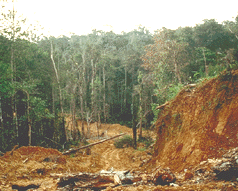Updated the number of wedges 3/08
The term solution is often reserved today for technologies or policies that can be implemented immediately, and ramped up over 50 years to save 1 gTC/year in the 50th year (1 billion metric tonnes carbon, about 3.7 metric tonnes carbon dioxide, about 4 tons carbon dioxide). Over 50 years, 25 gTC (92 gTCO2) will be kept out of the atmosphere. Possible future methods (fuel cells, fusion power) of reducing GHG emissions, and smaller contributions from current technologies (wave motion) may help, but they are currently getting less attention.
Articles on solutions often refer to the seven wedges needed to stabilize greenhouse gas emissions by 2050 (first referred to in the Pacala-Socolow article in Science, subscription needed). However, most analyses in the climate community indicate that lower emissions targets are crucial. The California goal is to reduce GHG emissions to 80% below 1990 levels.
While the number of 7 wedges to stabilize is widely cited, the underlying assumptions are not. Pacala and Socolow look only at carbon dioxide emissions (so they exclude deforestation, for example) and concrete, ignoring all other greenhouse gases. They assume 1.5% increase/year while Intergovernmental Panel on Climate Change Working Group 3 (Mitigation) reports assumptions of 1.1% to 2.5% increase/year between now and 2030, with more recent assumptions higher.
Biological and other feedback mechanisms have not been counted: a changing climate produces positive feedback. Darker plants grow in warmer climate, absorbing more of the sun’s energy; lianas (vines) replace trees (more carbon added to atmosphere); decreased carbon storage in the soil; a reduced carbon uptake by the ocean — allocate a portion of a wedge, or more, to compensate for positive feedback.
IPCC doesn’t use wedges, and no one looks at any plans that lead to stabilization beginning this year. To simplify the matter, suppose we do introduce as many wedges as are needed this year, and reduce GHG linearly over the next 50 years, to 80% below 2008 levels, assuming a 2%/year increase from 2004.
CO2 emitted (doesn’t count deforestation) plus concrete:
integrate 26e^0.02t from year 4 to year 54, because it’s already 4 years after 2004: total = 2,420 gT CO2
Linear decrease from 2008 to 2058 from 26 gT CO2 to 80% lower:
50*[1/2*(26 + 20%*26)] = 780 gT CO2
To keep 2,420 – 780 = 1640 gT CO2 out of atmosphere:
1640 gT/92 gT/wedge = 18 wedges
The assumptions for the calculations are too simple. Other analyses assumes that GHG will continue to rise until 2000-2015, and then fall more rapidly. If 2000 is assumed to be the year of peak emissions, then more wedges are needed, if 2015, fewer. The assumption in World Energy Outlook 2004 is a 1.7% yearly increase in CO2 for the reference scenario, less than 2%, which in turn is less than the highest estimates. If the rate of increase in carbon dioxide due to business as usual is larger than 2%, or the rate of emissions reduction desired is more rapid, even more wedges will be needed. The opposite is true as well. More wedges are needed to achieve an 80% reduction by 2050, compared to 2058. BAU assumptions after 2030 differ.
Even faster reductions would lower the risk of catastrophic sea level rise, and reduce overall harm from climate change. After 2050, the goal is to zero out carbon emissions to protect the ocean, though many marine experts would like to see much more rapid decreases in carbon emissions.

Inez Fung is among those worried that the “breathing biosphere” may be overwhelmed, and that as the climate warms, ocean mixing slows, reducing ocean absorption of carbon dioxide.
The Carbon Mitigation Institute posts Socolow-Pacala analyses for different wedges.
According to their information (with caveats provided by me), how easy is it to get to 18 wedges? Some double counting occurs: we can reduce emissions from driving by one half either by driving half as much, or reducing the greenhouse gas intensity by half. Doing both does not reduce GHG emissions by 100%.
The largest number of wedges, and immediately the cheapest (they can be done at negative cost, up to a point), are from improved efficiency. An IPCC paper estimates that 2 wedges could come from improvements in buildings (perhaps more?); these include either voluntary or mandated easy behavior changes, such as better building design, retrofitted changes to current stock, improved appliances, changing light bulbs from incandescent, etc. Doubling fuel economy of light duty vehicles from 30 to 60 mpg could produce one wedge savings. Reducing average car use from 10,000 miles/year by half could also produce a wedge. Living in smaller, colder or warmer, darker housing is not evaluated, but I would suspect that there will be a shift to more apartments in larger cities. Perhaps mandates on temperatures in public buildings could lead to changed temperatures in private ones.

Will more bicyclists and pedestrians be part of a wedge?
Biological and Geological Sequestration
Deforestation and afforestation could provide a wedge – decrease current deforestation to zero and add quite a bit of forest. Conservation tillage could help. Some of this analysis may be based on older more optimistic calculations. More efficient coal plants or/and long-term storage (geological sequestration) of the carbon emissions can help.



This is very helpful, once I get past the particulars of the second paragraph which are hard for me to decipher —
I find especially persuasive your list of “if’s” under “How many wedges can we reject” — Thanks for continuing to make clear the enormous risks of continuing to reject the nuclear option. I don’t know what it will take, however, to resolve the almost primitive fear that has somehow been implanted in the public consciousness — Will our fear of climate change — resting on hypotheses — ever replace our fear of the invisible power of the nuclear “genie” —
I want to return to your blog on relative radioactivity of coal — where will I find it?